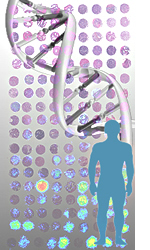Human genetics facts for kids

Human genetics is the study of how traits and characteristics are passed down from parents to children. This process is called inheritance. It helps us understand what makes each person unique.
This field looks at many things. It includes studying genetic conditions that people can inherit. It also involves exploring the entire set of human genes, known as the human genome. Genetic counseling is another important part. This is where experts help families understand genetic risks.
Genes are like tiny instruction manuals inside our bodies. They control most of the traits we inherit. By studying human genetics, we can learn more about what makes us human. It also helps us understand why we get certain diseases. This knowledge can lead to better ways to treat illnesses.
Contents
What are Genes?
Genes are small parts of DNA. DNA is a special molecule found in almost every cell of your body. Think of DNA as a long, twisted ladder. Genes are specific sections on this ladder. Each gene carries instructions for building a particular protein. These proteins do most of the work in your cells. They also make up the structures of your body.
For example, some genes give instructions for your eye color. Other genes might tell your body how to grow tall. You inherit half of your genes from your mother and half from your father. This mix of genes is why you share some traits with both parents.
How Do Traits Pass Down?
The way traits pass from parents to children is called inheritance. It happens through chromosomes. Chromosomes are structures found inside your cells. They contain your DNA and all your genes. Humans usually have 46 chromosomes in each cell. These are arranged in 23 pairs.
One pair of chromosomes determines if you are male or female. These are called the sex chromosomes. Females have two X chromosomes (XX). Males have one X and one Y chromosome (XY). The other 22 pairs are called autosomes. They carry genes for all other traits.
When a baby is made, it gets one chromosome from each pair from its mother. It gets the other chromosome from each pair from its father. This random mix is why siblings can look different. Even though they come from the same parents, they get different combinations of genes.
Understanding Genetic Conditions
Sometimes, there can be changes or mistakes in genes. These changes are called mutations. Some mutations can cause genetic conditions or diseases. For example, cystic fibrosis is a genetic condition. It affects the lungs and digestive system. It happens when a person inherits two copies of a changed gene.
Studying human genetics helps scientists find these gene changes. This knowledge is important for many reasons. It can help doctors diagnose conditions earlier. It can also lead to new treatments. Sometimes, it can even help prevent certain diseases.
The Human Genome Project
The Human Genome Project was a huge scientific effort. It started in 1990 and finished in 2003. The goal was to map out all the genes in human DNA. This means scientists wanted to find the exact location of every gene. They also wanted to figure out the order of the chemical "letters" that make up each gene.
This project was a big step forward in human genetics. It gave scientists a complete "book" of human genetic instructions. This book helps researchers understand how genes work. It also helps them find genes linked to diseases. The Human Genome Project has opened many doors for new medical discoveries.
Genetic Counseling
Genetic counseling is a service that helps people understand genetic information. A genetic counselor is an expert. They can explain how genetic conditions might run in families. They can also talk about the chances of passing a condition to children.
People might seek genetic counseling for different reasons. For example, a couple might want to know their risk of having a child with a genetic condition. Or, someone might want to understand a genetic diagnosis they received. Counselors provide information and support. They help people make informed decisions about their health.
Related pages
Images for kids
See also
 In Spanish: Genética humana para niños
In Spanish: Genética humana para niños


